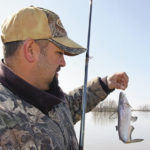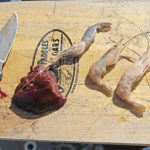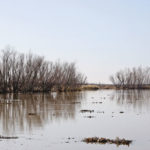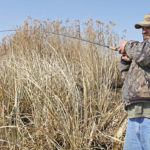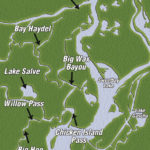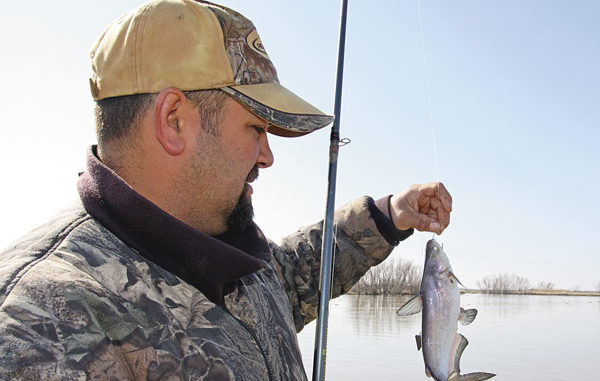
Looking for the main dish for a weekend fish fry? Then head to Lake Salve, where the cats are big and eager to strike.
“Bully, bullyyy,” chanted my fishing partner Joey Ratcliff almost to the tune of the old Sam the Sham and the Pharoahs 1965 hit Wooly Bully after he grunted hooking a big blue catfish. Ratcliff’s pole bent over in an arching half-pipe as he muscled up on the blue bully, pulling it to the surface. At the side of the boat, the catfish swirled with contempt, but it was too late — its fate was sealed.
“You’re the man, Joey,” I said.
“I am the man!” he exclaimed. “That’s what I’m talking about. I told you I know where the fish are.”
What Ratcliff knows, along with other locals upriver, is that Lake Salve and its surrounding bayous have some amazing catfishing during the early spring. Not just with jug-lines, fish boxes and trotlines, but with rod and reel too.
What makes this region below Berwick so good each spring? Ratcliff says a lot of it has to do with the water depth.
“The water in the winter and early spring is pretty warm because it’s kind of a shallow area,” he said. “Some of the bayous in the area don’t get too deep, so the water has time to warm up. Also, the currents are good.”
It’s the combination of water depth and current in the bayous that draws catfish. But additionally, the water draining from the vast marshes is loaded with baitfish, river shrimp and other organisms supplying an enormous and steady food source for hungry catfish.
Blue catfish are aggressive — even known to hit a bass fisherman’s spinnerbait. That aggressiveness can be taken advantage of.
Ratcliff, 33, over the years has discovered a key element that has worked for him in putting catfish in the ice chest — a trash line.
“I’ve noticed, just about everywhere I’ve caught fish down there, there is usually a little trash floating, like lilies,” he said. “That trash holds a lot of bait like river shrimp. There’s river shrimp clinging to the trash because they eat the little plankton. And there’s a lot of shad that congregate around it that eat the river shrimp. It also gives shade for catfish to get out of the sun. Catfish will hang close to the trash line and feed on whatever they can get a hold of — river shrimp or shad.”
Anglers entering the Lake Salve area will have to spend some time reading the waters. Another key to look for is eddies.
An eddy will form a back flow of water as a result of some obstruction. In the case of the marshes south of the Intracoastal Canal, the obstruction is usually where the mouth of a canal meets a bayou or possibly convergent bayous.
“I like a slow eddy,” Ratcliff said. “If you can find an eddy with a trash line that’s moving kind of slow, it’s good. You don’t want a lot of current because the fish can’t stay still in it. And with a slow eddy, it gives the fish a place to get out of the current — out of the fast, fast current. Usually in a curve along the bayou, you try to find backing-up water. That water coming back around forming an eddy will usually have a hole there. Catfish sit in those holes along the drop-offs.”
Another observation that Ratcliff has noticed over time is that there seems to be a transition coming out of the winter months, going into spring, where size, numbers and the type of catfish are concerned.
“During the winter, you catch a lot of bigger fish,” Ratcliff said. “I’m not sure what the reason is or why, but you just catch bigger fish in the winter and less numbers. In the spring — towards the summer months — you catch much smaller fish, but you also catch higher numbers. You also start catching what we call eel cats.”
What Ratcliff refers to as eel cats are channel catfish, also known as willow catfish and spotted catfish. Another species of catfish not targeted but periodically caught in far less numbers in the region is the flathead catfish, known also as yellow catfish and Opelousas catfish.
Catfishing along the Atchafalaya River and its tributaries is pretty much a tightlining affair when it comes to rod-and-reel methodology. When Ratcliff fishes the Lake Salve area, he is no different but does change up a few things.
“I don’t like to use the store-bought rigs most people buy, with all that stuff on it,” he said. “In my opinion, it makes noise and tends to be something the fish see that doesn’t look natural.
“I like to make a staging off my main line itself about 16 inches off the bottom. On the bottom, I’ll use a 1-ounce weight. I also use a 1/0 kahle hook. It’s a small hook, and I find the smaller the better. It tends to go into their mouth really easy, and it’s hard to miss them. It’s almost a definite hookset every time.”
Line weight runs the gamut. Any durable line from 10- to 15-pound-test is sufficient. Fifteen-pound-test will handle large blue cats many times beyond the line’s rating — even in heavy current and deep river waters. Additionally, catfish aren’t known for long, hard fights, easily tiring after a few initial runs that will bend most graphite rods to the brink.
Heavier blue catfish, like those Ratcliff and I flexed our muscles on, are fun to catch. Though most people prefer smaller 1 1/2- to 2-pound fish for eating, big blue cat meat is great for cutting into strips or even cubes for courtbouillon.
Lake Salve itself is very shallow. Ratcliff typically starts probing for catfish in the shallows and progressively moves to deeper water in the locations he’s come to know hold fish.
“I like to fish the shallows first,” Ratcliff said. “If the fish are on, I’ve got more time to fish. But if it isn’t happening, I’ll move from 2 or 3 feet of water to 6 or 7. And if no luck there, I’ll go to deeper locations. You can’t always pinpoint how deep of water at first you need to go to catch fish. That’s why I like to start shallow and work my way to deeper water.”
His favorite coldwater bait is nutria liver. Prior to our outing, Ratcliff, who has a bounty permit to hunt nutria, made it a point to go out and shoot a couple to demonstrate its effectiveness.
I have to admit, as a bonafide believer and near exclusive user of river shrimp, Ratcliff put three blue bullies in the boat on rat liver before I landed my first fish on my favorite bait.
